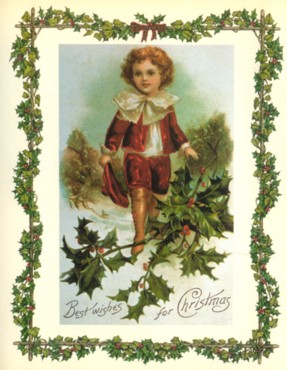|
Holly and the IvyChristmas Magic Of all the trees that are in the wood, the holly and the ivy come into our lives forever linked as symbols of traditional Christmas. They have gathered myths and legends wherever they grow. At the heart of the matter, theirs is a story about new life. Pagans, first, and then early Christians were awe-struck by these plants that remained green of leaf and ripe of berry when all else is bare in a northern midwinter.
So it is not surprising that traditions grew up in which both plants were consulted to discover where life and particularly love might lead in the year ahead. (from the book "The Holly and the Ivy") Holly is associated with males and is considered to bring men good luck and protection; traditionally the female counterpart to holly is ivy. Why do we decorate with holly at Christmas? During the holiday season, it adorns houses all over the world. The prickly green plant and its red berries are a popular ornament for those looking to enliven their homes with a little color and Christmas spirit. But where did this tradition begin? Why do we deck our halls with boughs of holly every December? What does holly represent in the celebration of Christmas? Before holly was hung in houses to accompany Christmas trees, it was considered to be a sacred plant by the Druids. While other plants wilted in winter weather, holly remained green and strong, its berries a brightly colored red in the harsh bleakness of winter. The Druids regarded holly as a symbol of fertility and eternal life, thought to have magical powers. In Druid lore, cutting down a holly tree would bring bad luck. In contrast, hanging the plant in homes was believed to bring good luck and protection. Holly was also thought to protect homes against lightning strikes. Romans associated holly with Saturn, the god of agriculture and harvest, and decked the halls with its boughs during the festival of Saturnalia.
The literal translation for all of these terms is "holly," but the origin is probably the Proto-Indo-European (the ancient root language of the Indo-European languages) base, qel, which appropriately means "prickly" or "to prick." Even in ancient times, people took advantage of the sharp ends of holly's leaves. The Druids hung it on windows and doorways to fend off evil witches and spirits. Holly is known for its vibrant red color, which stands out against the starkness of winter.
One line states that "The holly bears a berry/As red as any blood/And Mary bore sweet Jesus Christ/To do poor sinners good." Another line says "The Holly bears a prickle/As sharp as any thorn/And Mary bore sweet Jesus Christ/On Christmas Day in the morn"
Holly and the Ivy
|

 They have always been talismans of rebirth, a sign that spring is near.
They have always been talismans of rebirth, a sign that spring is near.

